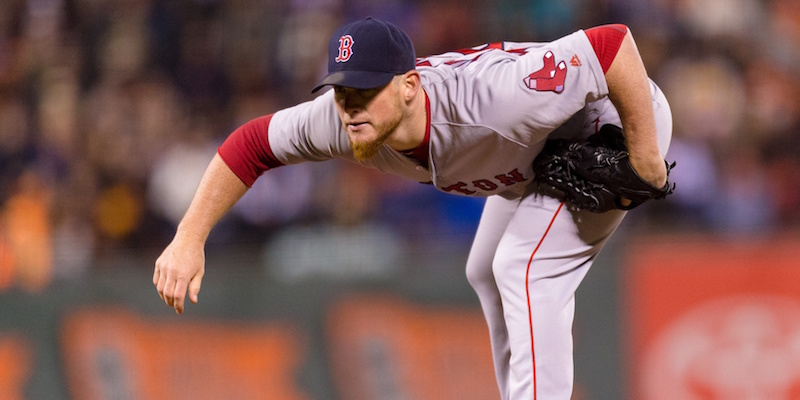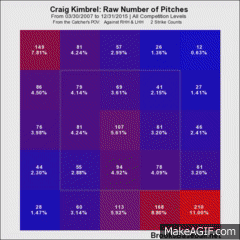The Red Sox are a very good team. They currently have a one-game division lead and have a three-game cushion for a postseason spot. Bad teams don’t put themselves in that kind of position. On the other hand, the Red Sox are a very frustrating team. Like most frustrating baseball teams, their biggest issue lies in the bullpen. Overall on the season, the numbers aren’t too bad, but over the last month or so it’s been a tough go for the relief corps. As Matt Kory discussed last week, the pitching staff just hasn’t been getting it done in high-leverage situations. In a way, Craig Kimbrel is the epitome of frustration in this bullpen.
Obviously, the Red Sox gave up a sizable prospect package in order to acquire their new closer over the offseason. With that kind of trade comes significant expectations. I don’t think it’s unfair to say that he hasn’t exactly lived up to those expectations. Of course, it’s also fair to say those expectations were wholly unfair. Overall, Kimbrel has actually been quite effective in 2016. Through his first 46 games, he’s posted a 2.86 ERA, a 2.58 FIP, a 2.90 DRA and an 82 cFIP while striking out more than 14 batters per nine innings. Those are dominant numbers. The disappointment comes from the fact that he’s blown two saves and has four losses on the season. It also stems from his struggles in non-save situations, something that has developed into an out-of-control narrative. However, even if the hand-wringing over his season is almost certainly overblown, there is one portion of his game that is worthy of the criticism it’s gotten. That, of course, is his control.
Now, Kimbrel has always had some issues with walks over his career. He’s been dominant enough in the other aspects of the game to overcome whatever issues he’s had. With that being said, he’s never had control problems quite to this degree. To this point of the season, he is walking 4.5 batters per nine innings, well above his previous career-high of 3.8*. Additionally, he’s already hit three batters, which ties his career high. *Excluding his rookie year in which he only threw 20 innings.
Kimbrel is throwing the ball in the zone at a lower rate than 84 percent of the pitchers who have tossed at least 750 pitches this year.
The odd thing about this, however, is that his overall plate discipline numbers don’t jump out as indicators of a pitcher who has completely lost his ability to throw strikes. He is hitting the zone just 44 percent of the time, which is a career low, but it’s not too far off his mark from last year. On the other hand, it is a lower rate than 84 percent of the pitchers who have tossed at least 750 pitches this year, so it’s possible that he just got a bit lucky in 2015. Still, he’s getting plenty of swings on those pitches out of the zone, as his 30 percent O_Swing_RT is just a shade off his career marks. So, while these numbers certainly describe a pitcher with control issues, they don’t suggest a major change from previously in his career.
Things get even stranger when you look at how he starts at-bats. We hear constantly about how important it is for a pitcher to start an at bat off with a strike. It makes sense, of course, as immediately gaining the upper-hand clearly makes it easier to get a desirable result. That hasn’t exactly been the case for Kimbrel. According to Fangraphs’ plate discipline numbers, he is throwing his first pitch for a strike 68 percent of the time, which is the second-highest total of his career after his incredible 2012 campaign. In fact, of the 348 pitchers with at least 40 innings under their belt this year, only 15 have thrown their first pitch for a strike more often.
The real issue for Kimbrel has been his inability to put hitters away when he has the advantage. Using Baseball-Reference’s Play Index, we can see how pitchers perform after they start a count off 0-1. Going off that same sample of pitchers who have thrown at least 40 innings, only 39 have walked batters at a higher rate after throwing a first pitch strike. In particular, Kimbrel is having more trouble than usual throwing strikes after getting two on the opponent. Prior to this season, the righty only threw his fastball for a ball 31 percent of the time with two strikes, while the rate was 34 percent for his curveball. He’s used the pitches at roughly the rate this year, but his fastballs have gone for balls 41 percent of the time and his curveballs 38 percent. Below, you can see the zone profiles with two strikes in gif form, with one frame showing his career through 2015, and the other showing only 2016.
The big increases in 2016 are above the zone and off the plate to the glove side. To me — and I want to emphasize that this is pure speculation — this is the sign of a pitcher who is overthrowing. Whether that’s too much adrenaline (is that possible for a closer?) or putting pressure on himself, he appears to be trying too hard to finish off batters, which is allowing those opponents back into the at-bat.
Generally speaking, there is nothing to worry about with Kimbrel. In a bullpen with plenty of problems, the closer is still one of the better options in baseball, even if he’s not quite the same generational talent he once was. With that being said, the control issues are still getting him into trouble, and it would be nice if that were rectified. He’s done well starting off batters with strikes, now he just needs to ease up a tad and put batters away once he gets the advantage.
Photo by John Hefti/USA Today Sports Images


Matt, in all my years of watching and playing baseball I have never seen a Pitcher with a pre throw routine like Kimbrel. I am referring to him looking over towards third base for a long time and then turns and throws . He does this every time whether there are runners on or not. In almost all activities that require moving something to a target you want to focus on the target so you can feel the motion required to hit itYou don’t want to pick up your target at the very last second.. You wouldn’t expect a QB to look entirely in the opposite direction before turning to find his target and throw so why would throwing a baseball to a target be any different. I hope somebody picks up on this and works with him..